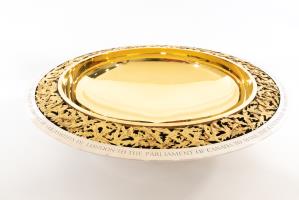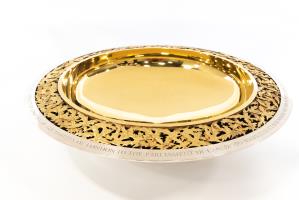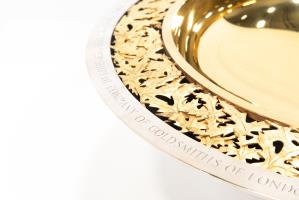O-2012 • bowl (commemorative) • Presentation Bowl 1967
Specifications
| Artists | Stuart Devlin (The Worshipful Company of Goldsmiths) (Artist) |
|---|---|
| Date | 1967 |
| Inscriptions |
DON DE LAVÉNÉRABLE CORPORATION DES ORF'VRES DE LONDRES AU PARLEMENT CANADIEN Ä L'OCCASION DU CENTENAIRE DE LA CONFÉDÉRATION 1967.GIVEN BY THE WORSHIPFUL COMPANY OF GOLDSMITHS OF LONDON TO THE PARLIAMENT OF CANADA TO MARK THE CENTENNIAL OF CONFEDERATION 1967.
|
| Materials | metal, sterling silver • metal, sterling silver gilt • metal, gold |
| Dimensions (cm) | 13.0 (Height) • 56.0 (Outside Diameter) |
| Functions | Ceremonial artifact |



Stuart Devlin / The Worshipful Company of Goldsmiths
Stuart Devlin was born in Australia in 1931. A gifted metalworker specializing in gold and silver, he won a 1964 competition to design Australia’s new decimal-system coinage. He emigrated to England and opened a workshop in London in 1965. In 1982 he was granted membership in the Worshipful Company of Goldsmiths and went on to serve as the Company’s Prime Warden in the mid-1990s. He later worked with the guild to develop a new training institute for goldsmiths. Devlin suffered a stroke in 2014 and died four years later in England.
London’s Worshipful Company of Goldsmiths received its first royal charter in 1327, with authority over provincial guilds and the right to enforce product standards. In 1363, all gold- and silversmiths in Britain were required to identify their work with a unique maker’s mark, and by the end of the 15th century, the Company was regularly inspecting products at its “assay office” in Goldsmiths’ Hall. Its mark confirming an object’s quality came to be known as a hallmark. To this day the Company maintains an office where items made of precious metals (now including platinum and palladium) are tested for purity.